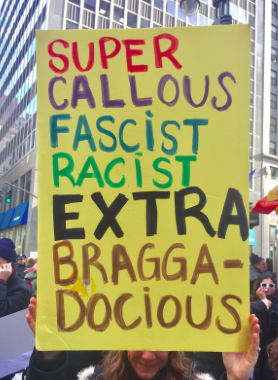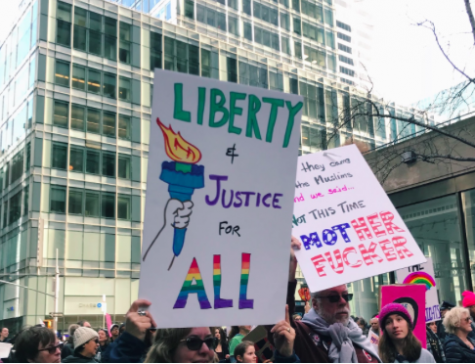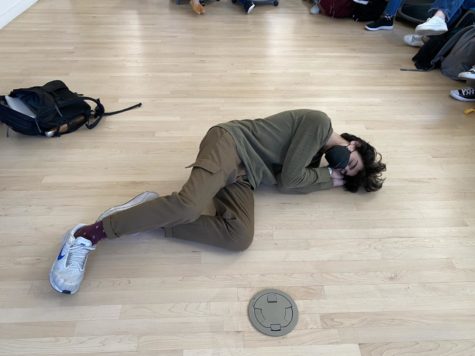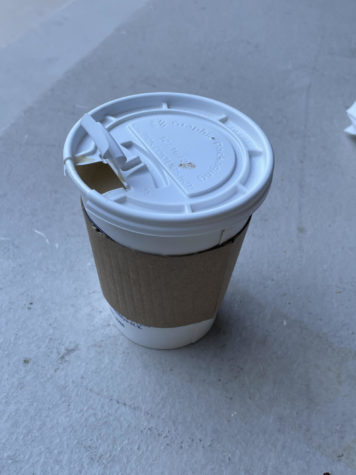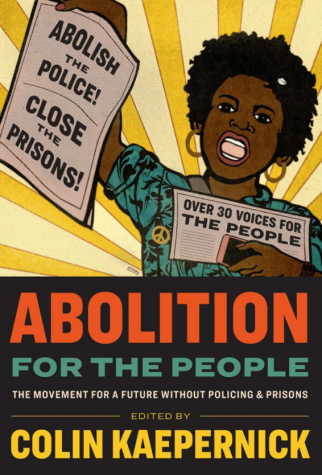Power to the People: The 2018 Women’s March
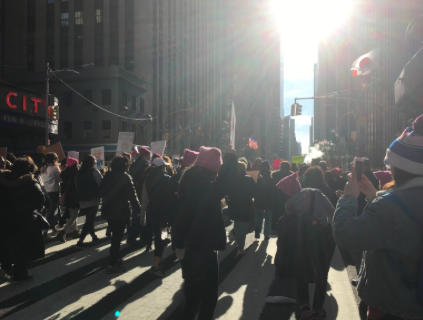
The 2018 NYC Women’s March. Picture by Moya Linsey.

As my friends and I jumped over the police barrier put in place to prevent New Yorkers from entering the Women’s March, I couldn’t help but think how idiotic the police were for actually believing that a small and very jumpable fence would keep the protesters out of the streets. People were pouring in from every side, and some police officers even capitulated to the growing crowd. Almost every single person there was determined for their message to be heard by the moronic President of the United States–that they were still there and would not be silent.
In comparison to last year’s protest, the 2018 Women’s March was definitely more resigned– it was almost halved in size, and the hopeful energy that previously dominated was clearly lacking. On the other hand, however, there was a very persistent and persevering feeling. While last year’s march was a testament to hope and camaraderie amongst women and Democrats, this year’s inspired courage and resilience.
A year after Trump’s inauguration, hundreds of thousands of protesters poured into the streets, motivated by their contempt for both the President and his policies. Coming only a short time after the #MeToo movement, a movement that has pushed feminists to continue the fight for social and political change, women across the nation are more enraged and galvanized than ever. Activists are planning to build on the momentum created by the movements and transfer some avidity into the oncoming midterm elections.
Although the march was drastically smaller than 2017, the 2018 Women’s March did generate a good turnout. According Mayor Bill De Blasio’s office, more than 200,000 protesters came out in New York City. The Mayor of Los Angeles, Eric Garcetti, claimed 600,000 people attended the march there, and Chicago officials estimated around 300,000 marchers in the Windy City. Numerous other marches were held throughout the nation, and a rally called “Power To The Polls” was held the day after. “Power To The Polls” was, once again, organized by the leaders and co-founders of Women’s March Inc., to encourage citizens to get out and vote in the 2018 midterm elections. Activists are hoping for a Democratic majority in the House of Representatives, a change that would stop President Trump’s aggressive and careless policies towards a variety of highly-contested topics including immigration, health care, and human rights.
Furthermore, many high-profile women took the stage at many of the marches across the country. In Los Angeles, actresses Natalie Portman, Viola Davis, and Scarlett Johansson were among the many people to address protestors. Encouraged by the #MeToo movement, which created after a barrage of sexual harassment claims against powerful hollywood stars, the three actresses gave personal stories about “sexuality” in Hollywood, read poems, and talked about the hope that the movement has inspired.
In Washington, political leaders, such as Nancy Pelosi, the House minority leader and a Democrat from California, addressed the large crowds assembled there. They praised the women running for seats in the government, adding that it in order for a democracy to truly be a democracy, women are needed at the top. Senator Kirsten Gillibrand, a Democrat of our own New York, said “It’s women who are holding our democracy together in these dangerous times… To change the system, we need to change the players and have women at the table.”
President Trump even felt the need to take to twitter to comment on the Women’s Marches, a sure sign that he was feeling threatened. Ironically, the marches all had very strong anti-Trump message, and the movement would not have even existed without Trump’s overtly sexist attitude. He tweeted, “Beautiful weather all over our great country, a perfect day for all Women to March. Get out there now to celebrate the historic milestones and unprecedented economic success and wealth creation that has taken place over the last 12 months. Lowest female unemployment in 18 years!” Not only is this statement completely hypocritical due to the President’s past behavior, it’s also wrong. The unemployment rate for women over the age of 20 has actually been steadily dropping since Obama’s administration, so it’s an achievement that we should really accredit to him (Bureau of Labor Statistics).
Additionally, the government shut down on the day of the march further encouraged marchers to take to the streets. The shutdown was caused over a dispute about the abolition of the DACA. Democrats refused to agree on a federal budget without a pledge to reconsider the reinstallation of the act, which would protect the children of undocumented people living in America. Eventually the Democrats did capitulate, but not without a fight.
Although this most recent Women’s March did inspire hope, it was more subdued than the previous protests. In a tweet, former Secretary of State and presidential candidate in 2016, Hillary Clinton, said it perfectly: “In 2017, the Women’s March was a beacon of hope and defiance. In 2018, it is a testament to the power and resilience of women everywhere.” Rest assured, this power and resilience is not going anywhere. Until Trump is out of office, the iconic pink pussy hats will continue to come back every year, fighting stronger than ever. As many of the signs read, “Respect our existence or expect our resistance.” President Trump has made himself a very powerful and unrelenting enemy– an entire nation of very antagonized, nasty women.
